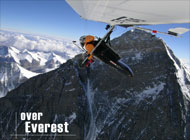Why Are So Many People Dying on Everest?
Why are so many people dying on Mount Everest, asks doctor and climber, Andrew Sutherland in this week’s BMJ?
It used to be thought that it would be physiologically impossible to climb Mount Everest with or without oxygen. In 1953 Hillary and Tenzing proved that it was possible to reach the summit with oxygen and in 1978 Messner and Habeler demonstrated it was possible without oxygen.
Although Everest has not changed, and we now have a better understanding of acclimatisation, improved climbing equipment, and established routes, it would therefore seem logical that climbing Everest might have become an altogether less deadly activity.
However, this year the unofficial body count on Mount Everest has reached 15, the most since the disaster of 1996 when 16 people died, eight in one night following an unexpected storm.
The death rate on Mount Everest has not changed over the years, with about one death for every 10 successful ascents. For anyone who reaches the summit, they have about a 1 in 20 chance of not making it down again. 
So why are there so many people dying on Mount Everest? And more importantly, can we reduce this number?
The main reasons for people dying while climbing Mount Everest are injuries and exhaustion. However, there is also a large proportion of climbers who die from altitude related illness, specifically from high altitude cerebral oedema (HACE) and high altitude pulmonary oedema (HAPE).
This year, the author was on the north side of Everest as the doctor on the Everestmax expedition (http://www.everestmax.com ) and was shocked by both the amount of altitude related illness and the relative lack of knowledge among people attempting Everest.
He writes: “On our summit attempt we were able to help with HAPE at 7000 metres, but higher up the mountain we passed four bodies of climbers who had been less fortunate. The last body we encountered was of a Frenchman who had reached the summit four days earlier but was too exhausted to descend. His best friend had tried in vain to get him down the mountain, but they had descended only 50 metres in six hours and he had to abandon him.”
“Some people believe that part of the reason for the increase in deaths is the number of inexperienced climbers, who pay large sums of money to ascend Everest,” he says. “In my view, climbers are not climbing beyond their ability but instead beyond their altitude ability. Unfortunately it is difficult to get experience of what it is like climbing above Camp 3 (8300 metres) without climbing Everest. Climbers invariably do not know what their ability above 8300 metres is going to be like.”
He suggests that climbers need to think less about ‘the climb’ and more about their health on the way up.
No matter what the affliction, whether it be HACE, HAPE, or just exhaustion, the result is invariably the same - the climber starts to climb more slowly, he explains. If you are too slow this means that something is wrong and your chances of not making it off the mountain are greatly increased. But with the summit in sight this advice is too often ignored.
When the author visited the French consulate in Kathmandu to confirm the Frenchman’s death, the consul, not a climbing or an altitude expert, shook his head and said, “He didn’t reach the summit until 12.30; that is a 14 hour climb - it is too long.”
British Medical Journal
Revision date: June 14, 2011
Last revised: by Andrew G. Epstein, M.D.